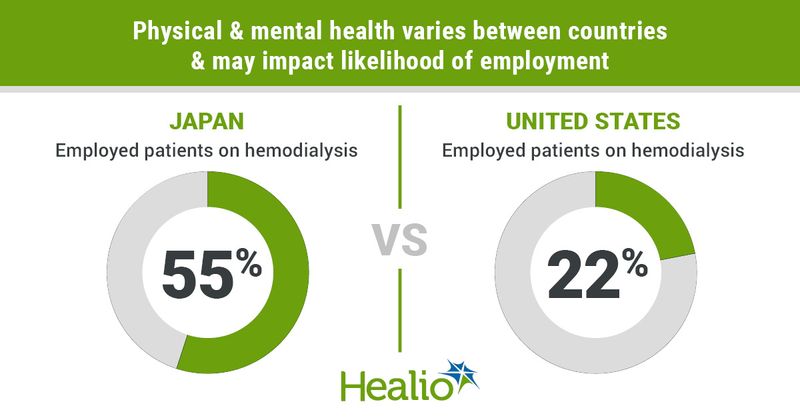Quality of life varies by country for patients on dialysis; US sees lowest employment rate
Click Here to Manage Email Alerts
An analysis of Dialysis Outcomes and Practice Patterns Study data revealed global variations in how patients perceive their quality of life, with functional status playing an important role.
In addition, patients receiving dialysis in the United States had the lowest rate of employment. According to investigators, results suggest employment status may be linked to reported physical and mental health.

“The effects that dialysis treatment can have on lifestyle, burden of disease, and quality of life (QoL) are important to patients receiving kidney replacement therapy and for their care partners,” Edwina A. Brown, DM, of Imperial College Renal and Transplant Centre at Hammersmith Hospital in London, and colleagues wrote. “Moreover, when facing the need for kidney replacement therapy, patients and their care partners, irrespective of the chosen dialysis modality, have important questions regarding their expected quality of life, the burden dialysis will place on them or their loved ones, whether these factors will change over time and what factors impact quality of life on dialysis.
“Another important consideration,” the researchers wrote, “is maintaining vocational abilities, with employment identified as an important outcome in the hemodialysis (HD) arm of the Standardizing Outcomes in the Nephrology Study (SONG) study. A core outcome of the peritoneal dialysis (PD) arm of SONG was maintenance of life participation activities.”
To examine the relationship between QoL and patient experiences (and how these may vary by region), researchers included 7,771 patients from six countries who participated in the Dialysis Outcomes and Practice Patterns Study (PD or hemodialysis).
Functional status and quality of life
Overall, lower functional status score (pointing to challenges performing basic tasks of daily living) was associated with lower physical component summery (PCS) and mental component summary (MCS) scores, a greater burden of kidney disease and a greater likelihood of experiencing depressive symptoms.
“Patient-reported outcomes were poor for patients with lower functional status,” the researchers wrote. “Thus, persons who need help with their daily activities will likely have lower physical and psychosocial functioning, experience a higher burden of kidney disease and have a higher risk of developing depression on dialysis.”
Impact of physical, mental health on employment
Centering on Japan, researchers observed that most of its patients had the highest possible score on the functional status scale (61% on hemodialysis and 67% on PD compared with about 33% of patients in other countries), the highest PCS score and the highest rates of employment (55% of patients on hemodialysis and 68% on PD).
However, the contrasting observation that patients in the United States had the highest MCS scores and lowest employment rates (22% of patients on hemodialysis and 42% on PD) led researchers to suggest employment status could be related to physical and mental health; because Japanese patients have the highest PCS scores, the researchers contended they are likely “more physically able to maintain vocational abilities.”
According to the researchers, employment and higher PCS scores could serve as proxies for better health status overall, as both have also shown associations with lower risks for hospitalization and mortality.
“However, it was somewhat surprising to learn that despite the higher employment and physical functioning in Japan, adjusted MCS scores were lower and kidney disease burden was higher,” the researchers wrote. “In contrast, in the U.S., which had the lowest proportion of patients employed, adjusted MCS scores were highest, along with lowest kidney disease burden and lowest odds of having depression symptoms. Taken together these findings may indicate that mental health and well-being may be compromised at the expense of struggles to maintain employment which may in part be driven by unique social and cultural factors operating within Japan.”
Researchers noted that, compared with the other countries, a physician diagnosis of depression was lowest in Japan (2% of patients on PD and 3% of patients on hemodialysis). This finding comes despite Japanese patients screening positive for depression at similar rates to patients in the United Kingdom; researchers recommend efforts be put toward improving depression diagnosis and treatment strategies.
“This information should be shared with patients and families when making dialysis modality choices, and in considering additional supportive care approaches for these patients,” Brown and colleagues concluded. “The present study also serves as a call to action to the nephology and kidney community to develop evidence-based strategies to identify and effectively treat depression, address symptoms, enhance treatment team-patient communication and develop novel therapeutic strategies in an effort to improve the patient experience on kidney replacement therapy.”

